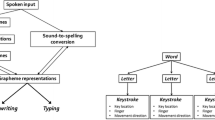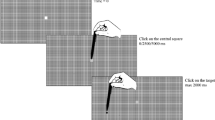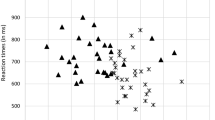Abstract
Skilled typing is controlled by two hierarchically structured processing loops (Logan & Crump, 2011): The outer loop, which produces words, commands the inner loop, which produces keystrokes. Here, we assessed the interplay between the two loops by investigating how visual feedback from the screen (responses either were or were not echoed on the screen) and the hands (the hands either were or were not covered with a box) influences the control of skilled typing. Our results indicated, first, that the reaction time of the first keystroke was longer when responses were not echoed than when they were. Also, the interkeystroke interval (IKSI) was longer when the hands were covered than when they were visible, and the IKSI for responses that were not echoed was longer when explicit error monitoring was required (Exp. 2) than when it was not required (Exp. 1). Finally, explicit error monitoring was more accurate when response echoes were present than when they were absent, and implicit error monitoring (i.e., posterror slowing) was not influenced by visual feedback from the screen or the hands. These findings suggest that the outer loop adjusts the inner-loop timing parameters to compensate for reductions in visual feedback. We suggest that these adjustments are preemptive control strategies designed to execute keystrokes more cautiously when visual feedback from the hands is absent, to generate more cautious motor programs when visual feedback from the screen is absent, and to enable enough time for the outer loop to monitor keystrokes when visual feedback from the screen is absent and explicit error reports are required.



Similar content being viewed by others
References
Abrahamse, E. L., Ruitenberg, M. F., de Kleine, E., & Verwey, W. B. (2013). Control of automated behavior: Insights from the discrete sequence production task. Frontiers in Human Neuroscience, 7(82), 1–16. doi:10.3389/fnhum.2013.00082
Crump, M. J. C., & Logan, G. D. (2010a). Hierarchical control and skilled typing: Evidence for word-level control over the execution of individual keystrokes. Journal of Experimental Psychology: Learning, Memory, and Cognition, 36, 1369–1380. doi:10.1037/a0020696
Crump, M. J. C., & Logan, G. D. (2010b). Warning: This keyboard will deconstruct—The role of the keyboard in skilled typewriting. Psychonomic Bulletin & Review, 17, 394–399. doi:10.3758/PBR.17.3.394
Crump, M. J. C., & Logan, G. D. (2013). Prevention and correction in post-error performance: An ounce of prevention and a pound of cure. Journal of Experimental Psychology: General, 142, 692–709.
Davies, M. (2008). The Corpus of Contemporary American English (COCA): 410+ million words, 1990–present. Available online at www.americancorpus.org
Diehl, M. J., & Seibel, R. (1962). The relative importance of visual and auditory feedback in skilled typewriting. Journal of Applied Psychology, 46, 365–369.
Fautrelle, L., & Bonnetblanc, F. (2012). On-line coordination in complex goal-directed movements: A matter of interactions between several loops. Brain Research Bulletin, 89, 57–64. doi:10.1016/j.brainresbull.2012.07.005
Gordon, A. M., & Soechting, J. F. (1995). Use of tactile afferent information in sequential finger movements. Experimental Brain Research, 107, 281–292.
Keele, S. W. (1968). Movement control in skilled motor performance. Psychonomic Bulletin & Review, 70, 387–403.
Keele, S. W., Cohen, A., & Ivry, R. (1990). Motor programs: Concepts and issues. In M. Jeannerod (Ed.), Attention and performance XIII: Motor representation and control (pp. 77–110). Hillsdale, NJ: Erlbaum.
Keele, S. W., & Posner, M. I. (1968). Processing of visual information in rapid movements. Journal of Experimental Psychology, 77, 155–158.
Lashley, K. S. (1951). The problem of serial order in behavior. In L. A. Jeffress (Ed.), Cerebral mechanisms in behavior (pp. 112–136). New York, NY: Wiley.
Logan, G. D., & Crump, M. J. C. (2009). The left hand doesn’t know what the right hand is doing: The disruptive effects of attention to the hands in skilled typewriting. Psychological Science, 20, 1296–1300. doi:10.1111/j.1467-9280.2009.02442.x
Logan, G. D., & Crump, M. J. C. (2010). Cognitive illusions of authorship reveal hierarchical error detection in skilled typists. Science, 330, 683–686. doi:10.1126/science.1190483
Logan, G. D., & Crump, M. J. C. (2011). Hierarchical control of cognitive processes: The case for skilled typewriting. In B. H. Ross (Ed.), The psychology of learning and motivation: Advances in research and theory (Vol. 54, pp. 1–27). Burlington, MA: Academic Press.
Logan, G. D., & Zbrodoff, N. J. (1998). Stroop type interference: Congruity effects in color naming with typewritten responses. Journal of Experimental Psychology: Human Perception and Performance, 24, 978–992. doi:10.1037/0096-1523.24.3.978
Long, J. (1976). Visual feedback and skilled keying: Differential effects of masking the printed copy and the keyboard. Ergonomics, 19, 93–110.
Miller, G., Galanter, E., & Pribram, K. (1960). Plans and the structure of behavior. New York, NY: Holt.
Rabbitt, P. M. A. (1966). Error correction time without external error signals. Nature, 212, 438. doi:10.1038/212438a0
Rabbitt, P. M. A. (1978). Detection of errors by skilled typists. Ergonomics, 21, 945–958. doi:10.1080/00140137808931800
Rieger, M., Martinez, F., & Wenke, D. (2011). Imagery of errors in typing. Cognition, 121, 163–175. doi:10.1016/j.cognition.2011.07.005
Rosenbaum, D. A., Cohen, R. G., Jax, S. A., Weiss, D. J., & van der Wel, R. (2007). The problem of serial order in behavior: Lashley’s legacy. Human Movement Science, 26, 525–554.
Rumelhart, D. E., & Norman, D. A. (1982). Simulating a skilled typist: A study of skilled cognitive-motor performance. Cognitive Science, 6, 1–36. doi:10.1207/s15516709cog0601_1
Salthouse, T. A. (1986). Perceptual, cognitive, and motoric aspects of transcription typing. Psychological Bulletin, 99, 303–319. doi:10.1037/0033-2909.99.3.303
Shaffer, L. H. (1976). Intention and performance. Psychological Review, 83, 375–393. doi:10.1037/0033-295X.83.5.375
Snyder, K. M., & Logan, G. D. (2013). Monitoring-induced disruption in skilled typewriting. Journal of Experimental Psychology: Human Perception and Performance, 39, 1409–1420. doi:10.1037/a0031007
Snyder, K. M., & Logan, G. D. (2014). The problem of serial order in skilled typing. Journal of Experimental Psychology: Human Perception and Performance, 40, 1697–1717.
Sternberg, S., Knoll, R. L., & Turock, D. L. (1990). Hierarchical control in the execution of action sequences: Tests of two invariance principles. In M. Jeannerod (Ed.), Attention and performance XIII: Motor representation and control (pp. 3–55). Hillsdale, NJ: Erlbaum.
Tapp, K. M., & Logan, G. D. (2011). Attention to the hands disrupts skilled typewriting: The role of vision in producing the disruption. Attention, Perception, & Psychophysics, 73, 2379–2383. doi:10.3758/s13414-011-0208-5
Verwey, W. B. (1999). Evidence for a multistage model of practice in a sequential movement task. Journal of Experimental Psychology: Human Perception and Performance, 25, 1693–1708.
West, L. J. (1967). Vision and kinesthesis in the acquisition of typewriting skill. Journal of Applied Psychology, 51, 161–166.
Wilson, M. (1987). MRC Psycholinguistic Database: Machine usable dictionary (Version 2.00). Cambridge, UK: Medical Research Council. Available online at www.psy.uwa.edu.au/mrcdatabase/uwa_mrc.htm
Yamaguchi, M., Crump, M. J. C., & Logan, G. D. (2013a). Speed–accuracy trade-off in skilled typewriting: Decomposing the contributions of hierarchical control loops. Journal of Experimental Psychology: Human Perception and Performance, 39, 678–699. doi:10.1037/a0030512
Yamaguchi, M., & Logan, G. D. (2014). Pushing typists back on the learning curve: Revealing chunking in skilled typewriting. Journal of Experimental Psychology: Human Perception and Performance, 40, 592–612. doi:10.1037/a0033809
Yamaguchi, M., Logan, G. D., & Li, V. (2013b). Multiple bottlenecks in hierarchical control of action sequences: What does “response selection” select in skilled typewriting? Journal of Experimental Psychology: Human Perception and Performance, 39, 1059–1084. doi:10.1037/a0030431
Author note
This research was supported by Grant Nos. BCS 0957074 and BCS 1257272 from the National Science Foundation.
Author information
Authors and Affiliations
Corresponding author
Rights and permissions
About this article
Cite this article
Snyder, K.M., Logan, G.D. & Yamaguchi, M. Watch what you type: The role of visual feedback from the screen and hands in skilled typewriting. Atten Percept Psychophys 77, 282–292 (2015). https://doi.org/10.3758/s13414-014-0756-6
Published:
Issue Date:
DOI: https://doi.org/10.3758/s13414-014-0756-6




